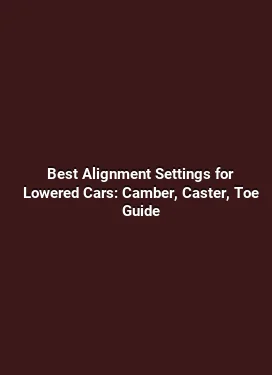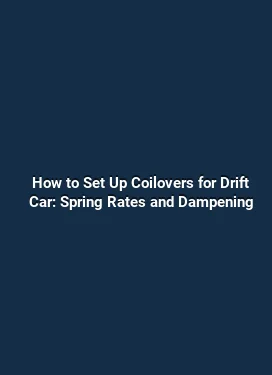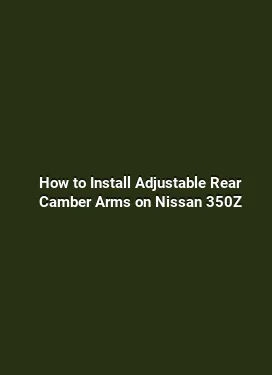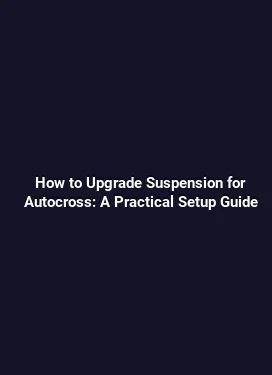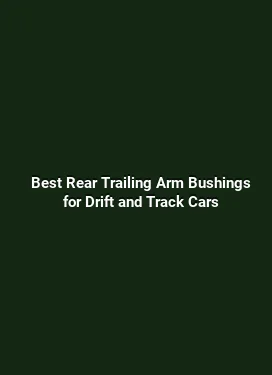Strut Tower Brace vs Subframe Brace: Which Improves Chassis Rigidity More?
When refining a vehicle for sharper handling and more predictable dynamics, enthusiasts often encounter two popular upgrade paths: installing a Strut Tower Brace (STB) or a Subframe Brace (SFB). Both aim to decrease chassis flex and harmonize suspension movement, yet they address different stiffness pathways and deliver distinct driving sensations. This article delves into the mechanical fundamentals, real-world implications, installation considerations, and practical outcomes of each option. The goal is to provide a clear framework for evaluating which brace type best suits a given vehicle, driving style, and track or street use case.
Understanding the role of chassis rigidity in suspension performance

Chassis rigidity refers to a structure’s resistance to deformations under load. In a typical front-wheel-drive or rear-wheel-drive layout, the suspension and steering components apply forces that propagate through the chassis. When the structure flexes, the intended alignment changes, causing shifts in camber, toe, and roll stiffness. These micro-movements can degrade steering feel, reduce tire contact patch optimization, and introduce unpredictable throttle-to-brake inputs during high-load cornering. The objective of both STB and SFB is to constrain the body in ways that preserve geometry under dynamic loads, enabling the suspension to operate within its designed range and the tires to maintain more consistent grip.
Understanding stiffness involves distinguishing between torsional rigidity (twisting), flexural rigidity (bending), and local stiffness near mounting points. A well-engineered chassis will distribute loads in a predictable manner, minimizing snap-through effects and avoiding parasitic motions that otherwise sap steering response. The two braces discussed here target different paths of load transfer: STBs primarily affect the upper structure around strut towers, while SFBs influence the structural coupling through the subframe assembly and chassis mounts.
Strut Tower Brace (STB): what it changes and what it does not
A Strut Tower Brace is typically a lightweight yet stiff bar that spans between the strut towers at the top of the suspension. The intent is to reduce tower-to-tower flex during braking, acceleration, and cornering by creating a pre-stressed, triangulated connection across the chassis dadoes that otherwise act as independent points of leverage for wheel hop and torques. In practice, STBs excel at minimizing capricious camber changes and steering wander caused by abrupt loads that push the strut towers apart or together.
From a handling perspective, the immediate benefits of an STB are often most noticeable in steering response and tactile feedback. Drivers may perceive a quicker, more linear steering feel with reduced dead spots when transitioning between throttle modulation and steering inputs. This effect is especially pronounced on vehicles with long strut towers and significant dynamic loads, such as front-engine, rear-wheel-drive cars or street-tuned performance machines with aggressive alignment angles. However, it is important to recognize that STBs have limited influence on the chassis’ torsional rigidity in the central tunnel area or the subframe connections. In other words, STBs are superb at stabilizing the upper structure but do not equally constrain flex in the lower chassis or through the subframe interface.
Installation considerations for an STB include mounting hardware quality, alignment with the actual tower positions, and ensuring that the brace does not interfere with hood clearance, brake fluid reservoirs, or brake booster lines. In addition, many modern vehicles employ active suspension components or complex brake ducts near the strut towers, so compatibility checks are essential. The aesthetic and weight factors are non-trivial as well; some drivers report a minimal increase in steering precision with a marginal weight penalty, while others may notice negligible differences if the factory chassis already exhibits high rigidity.
When to choose an STB

STBs are particularly useful in scenarios where the suspension relies heavily on the strut arrangement for initial geometry control, or in applications where a car experiences consistent, high-load cornering with noticeable body roll. If the primary aim is to improve steering feel, chassis predictability in mid-to-high-speed corners, and a more direct throttle-to-steering translation, an STB can be a pragmatic choice. Vehicles with a history of tower flex-induced camber loss or steering float during aggressive cornering often see a tangible improvement with a well-engineered STB. It is also a favorable option when budget constraints favor a targeted, non-invasive upgrade that preserves the original subframe and mounting points.
Subframe Brace (SFB): what it changes and what it does not
A Subframe Brace is designed to stiffen the structural coupling between the vehicle’s subframe and the chassis. This bracing typically connects the subframe mounts or the subframe itself to the main chassis at multiple points, creating a more rigid vertical and lateral load path. The result is a reduction in flex transmitted through the central part of the vehicle where the engine, transmission, and suspension components converge. In practice, SFBs contribute to improved control of body motions during dynamic loading, particularly under braking and during aggressive transitions, by keeping the subframe from distorting under load and by reducing micro-motions that can alter wheel alignment and suspension geometry.
Drivers can expect subtler yet meaningful improvements in straight-line stability and cornering consistency, especially on cars with high subframe compliance or with aftermarket trailing arms and lower control arms that introduce additional leveraging through the chassis. The gains from SFBs tend to manifest as better predictability in how the tires contact the road under heavy braking, throttle lift, or rapid directional changes. Importantly, SFBs influence the overall torsional stiffness of the chassis more than STBs, because they affect the central skeleton rather than the upper tower connections. A well-chosen SFB can reduce scuttle shake, improve NVH (noise, vibration, and harshness) transmission in some configurations, and contribute to more stable camber and toe behavior under load.
Installation considerations for an SFB include ensuring proper alignment with mounting holes, avoiding interference with engine or transmission skids, and verifying that the brace is compatible with any aftermarket subframe spacers or bushings. The additional hardware adds weight and may alter access to certain maintenance points, so engineers often weigh trade-offs between improved rigidity and serviceability. In many setups, the SFB’s contribution is complementarily amplified when paired with other rigid-body upgrades, such as chassis dampers or upgraded sway bars.
When to choose an SFB
Subframe Braces are especially advantageous on platforms that exhibit subframe flex under high-load conditions or on cars where the subframe acts as the central hub for suspension mounting. If a vehicle experiences noticeable yaw or pitch during abrupt transitions, or if the driver seeks tighter control of rear-end or front-end motions without excessively increasing steering stiffness, an SFB can offer meaningful gains. This is typical for cars with a relatively compliant body structure or chassis that tolerates some degree of flex under load, as the brace helps realign the load path to achieve a more consistent suspension geometry during cornering and braking.
Comparative gains: how much stiffness does each brace deliver in real-world driving?
Quantifying chassis stiffness gains from STBs and SFBs requires considering several interacting variables: the baseline rigidity of the chassis, the presence of other stiffness-enhancing components (roll cages, strut bars, anti-roll bars, subframe bushings), wheel and tire characteristics, and the driving environment (track vs street, temperature, tire pressures, and load cycles). In general terms, STBs tend to deliver more perceptible improvements in steering feedback and immediate steering response, especially on vehicles with tall strut towers and significant dynamic toe or camber variation. The perceived effect is often a crisper turn-in and a more confident sense of “that weight-on-patch” when entering a corner.
Subframe Braces typically provide a broader improvement in chassis rigidity, manifesting as reduced body flex during braking, improved high-speed stability, and more consistent tire contact under load. The gains here are most noticeable in the mid-corner physics and during transitions that stress the midsection of the chassis. For drivers who spend substantial time on track or engage in aggressive highway-to-corner drills, an SFB can yield a more gradual, linear increase in stability and a reduction in unpredictable chassis motions, particularly on cars with a marked subframe flex tendency.
Practical testing across various platforms suggests that performance gains from either brace are most pronounced when used in combination with complementary suspension upgrades. Pairing an STB with a high-quality SFB, upgraded sway bar ends, and properly tuned dampers can create a synergistic effect: improved steering precision, reduced chassis distortions, and a more cohesive roll stance. In contrast, relying on a single brace type may yield benefits, but the full potential often surfaces only when the entire suspension and chassis architecture are harmonized.
Practical selection guide: aligning goals, vehicle type, and driving use
Choosing between an STB and an SFB—or deciding to install both—depends on a structured assessment of goals, vehicle architecture, and expected usage. Start by identifying the primary driving scenario: daily driving with spirited backroad sections, weekend track days, or competitive racing. For street-only enthusiasts chasing immediate steering feel enhancements, a well-fitted STB can provide a noticeable upgrade in front-end response without dramatically altering the chassis balance. Conversely, for drivers seeking a more composed, predictable ride under high-load conditions, or for machines that exhibit pronounced mid-chassis flex, an SFB offers a broader platform stiffness improvement that translates into steadier cornering and more consistent tire loading.
Additionally, consider the vehicle’s existing rigidity characteristics. Modern performance cars often come from the factory with substantial chassis stiffness, reducing the marginal gains from STBs. In such cases, an SFB can be a more pragmatic path to meaningful improvements, especially when combined with compatible suspension tuning. It is also vital to verify compatibility with other aftermarket components, such as engine mounts, transmission mounts, and exhaust routing, to avoid unintended interference or NVH increases.
From a weight and cost perspective, STBs typically offer a lower-cost entry point with a modest weight addition, whereas SFBs may incur higher weights and more extensive installation. When evaluating value, drivers should assess not only the raw stiffness numbers but also the driving sensations: steering response, cornering predictability, tire contact stability, and overall chassis balance. Finally, do not overlook maintenance and longevity; ensure that any brace employs corrosion-resistant finishes and compatible hardware to withstand road salt, temperature cycles, and vibration over time.
Real-world installation scenarios and maintenance tips
Installation quality matters as much as the component itself. For an STB, verify that the brace does not contact the hood, strut tower tops, or brake lines during full steering lock and suspension travel. Some vehicles load the strut tower at the inner chassis rail point; ensure the mounting hardware uses appropriately rated studs or bolts with adequate clamping force. It is common to use thread-locking compounds and to torque fasteners to the manufacturer-recommended specifications to prevent loosening under heat cycles and road shocks. After installation, perform a basic alignment check to confirm that steering geometry has not drifted, and take the vehicle for a low-speed test drive to verify there are no unusual vibrations or rattles from the strut area.
For an SFB, assess the subframe mounting points for any signs of movement or play. Some installations require minor trimming or adjustments to fit around transmission or exhaust components. It is prudent to inspect bushings and mounts for signs of wear before installation, as pre-existing wear can influence the resulting stiffness and NVH profile. Post-installation, recheck wheel alignment and, if feasible, perform a road or track session to evaluate changes in turn-in, mid-corner stability, and braking behavior. If the vehicle exhibits unexpected NVH increases, review clearances and hardware tension, as excessive pre-load on the brace or improper seating can inadvertently transfer vibrations to the chassis.
Maintenance for braces is relatively straightforward: periodic visual inspection for corrosion, security of fasteners, and ensuring there is no contact with nearby components. For vehicles used in harsh climates, applying a rust-preventive coating to brace mounting points can prolong life. If any creaks or pops appear after pothole driving or track sessions, re-tighten fasteners to the correct torque and recheck alignment. Keep in mind that braces are part of a broader suspension ecosystem; if the vehicle continues to exhibit unpredictable handling, it may be time to revisit other components such as bushings, control arms, or dampers to ensure compatibility and to maximize potential gains from braces.
Trend-wise, more enthusiasts are incorporating modular chassis components that allow fine-tuning of stiffness across different axes. This approach enables a more customized balance between steering fidelity and mid-corner stability, tailoring the setup to personal preference and track conditions. The cumulative effect of a well-chosen STB or SFB, especially when integrated with tuned dampers and properly rolled tires, is a chassis that communicates more clearly through the steering wheel and a suspension that responds in a consistent, measurable way to driver input.
Common myths debunked
Myth 1: Braces dramatically increase top speed by reducing drag. In reality, braces influence dynamic load paths, not drag. The improvement comes from more efficient tire loading and predictable handling, not outright aerodynamic gains.
Myth 2: More rigid means always better. While rigidity helps some aspects of handling, over-stiffening can reduce compliance that is essential for tire patch contact on uneven surfaces. The best approach balances stiffness with controlled compliance to maintain grip on imperfect roads.
Myth 3: Any brace is better than none. Fitment quality, material strength, and resonance frequencies matter. A low-quality brace can introduce unwanted vibrations or interference with other components, nullifying potential benefits.
Putting it all together: a practical decision framework
To determine which option aligns with goals, create a simple decision matrix. Start with the vehicle platform and chassis architecture: does the car display significant subframe flex under load, or does it show more upper-tower flex during aggressive driving? If the subframe is the primary flex source and you crave overall mid-chassis stability, favor an SFB. If steering response and front-end stiffness are the priority, especially on vehicles with prominent tower structures, consider an STB. For those seeking a holistic upgrade, combining both braces can provide complementary benefits, though care should be taken to ensure proper fitment and no adverse interactions with other components.
Finally, the key to meaningful gains lies in a system-wide approach. Braces work best when paired with compatible suspension tuning—such as dampers with appropriate rates, race-grade bushings that maintain geometry, and wheels and tires tuned for the target stiffness. A thoughtful upgrade path, driven by road feedback and track testing, yields the most consistent gains over time and helps translate stiffening into measurable improvements in cornering grip, steering feel, and driver confidence.

